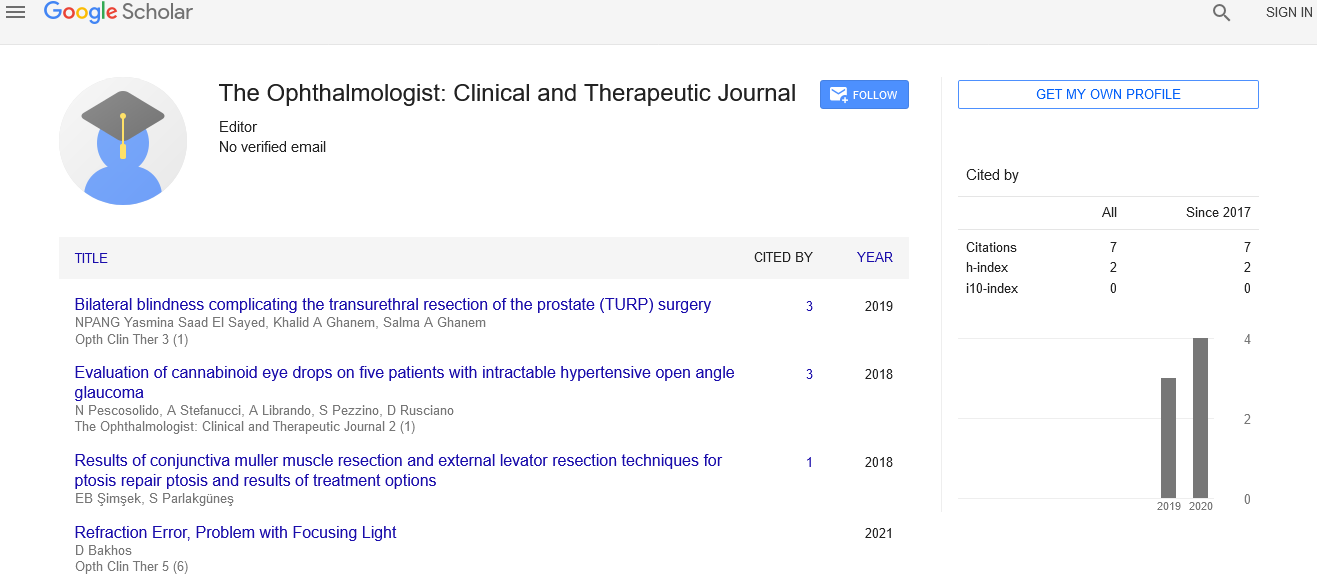Pediatric sinonasal rhabdomyosarcoma: points to ponder
Received: 12-Mar-2018 Accepted Date: Apr 02, 2018; Published: 09-Apr-2018
Citation: Citation: Parija S. Pediatric sinonasal rhabdomyosarcoma: points to ponder.Opth Clin Ther. 2018;2(1):7.
This open-access article is distributed under the terms of the Creative Commons Attribution Non-Commercial License (CC BY-NC) (http://creativecommons.org/licenses/by-nc/4.0/), which permits reuse, distribution and reproduction of the article, provided that the original work is properly cited and the reuse is restricted to noncommercial purposes. For commercial reuse, contact reprints@pulsus.com
Introduction
Rhabdomyosarcoma (RMS) is a highly malignant tumor and most common soft-tissue sarcoma of the head and neck in childhood [1]. The annual incidence is approximately 4.5 cases per million in children and 50% of cases are seen in the first decade of life. However it can still occur from birth to seventh decade of life [2]. RMS can occur in any part of the body except the bones. The common sites of occurrence of head and neck RMS are orbital, parameningeal and superficial. The locations of parameningeal RMS include nasal cavity, paranasal sinuses, nasopharynx, pterygopalantine fossa, middle ear and mastoid [3]. Although, orbital involvement is observed in 16% of cases compared to the parameningeal site in 10% of cases, yet the five year survival rate decreases from nearly 85% in orbital RMS to 50% for those with parameningeal tumours.
The clinical features are variable; basically appear to cluster around the site of the primary tumour, the age at diagnosis and histological subtypes [2]. RMS from paranasal sinuses presents with painless swelling, proptosis, sinusitis, nasal obstruction, epistaxis and cranial nerve palsies. Orbital RMS presents as a space-occupying lesion of the orbit. These features may pose as a diagnostic challenge as it may mimic other neoplastic and inflammatory masses. The histological subtypes of RMS have a prognostic significance with embryonal type being the least malignant and have a good prognosis. Sinonasal RMS is usually alveolar type, aggressive in nature with a risk for intracranial metastasis. Sinonasal RMS usually carries a poor prognosis and the risk of recurrence as these group is difficult to assess and resect.
Diagnostic modalities are computerized tomography (CT) and magnetic resonance scanning which helps to assess the spread of the disease. While evaluating the scans, particular attention is given to look for bone invasion and tumour extension into the cranial cavity and paranasal sinuses. Further bone scintigraphy is being used to detect osteoblastic metastasis. Certain studies have reported PET-CT to be superior at detecting bone and lymph node metastasis than CT and ultrasonography. The final diagnosis is based on immunohistochemical studies. The markers in RMS include antibodies against desmin (90%), muscle specific actin myoD1 (71-91%) and myoglobin. Myogenin is specific for alveolar type while vimentin and desmin are usually positive in RMS but is less specific.
RMS can occur sporadically or in association with familial syndromes with a predilection for other cancers such as Li-Fraumeni syndrome and neurofibromatosis type1. Pediatric rhabdomyosarcoma is a morphologically and genetically heterogeneous tumor. Genetically, the embryonal type is linked to loss of homozygosity on chromosome 11p15 while alveolar tumors often have a chromosomal translocation {t(2;13) (q35;q14)} that fuses the PA X3 gene with the FKHR gene, contributing to tumorigenesis [3]. The diagnosis of alveolar RMS is possible with polymerase chain reaction (PCR) assays, which is based on the presence of these hybrid genes. Future holds a potential in gene therapies with many ongoing clinical trials. Till date the management is based on the guidelines of Intergroup Rhabdomyosarcoma Study Group (IRSG) and European Cooperative groups. Current treatment includes surgery, radiotherapy and chemotherapy depending on the clinical staging and grouping of the tumour. The treatment of choice of parameningeal RMS in pediatric age group is chemoradiotherapy. Role of surgery is limited because of relative inaccessibility of the lesions and associated surgical morbidity.
Parija et al. reported a case which was based on the clinical feature of rapidly progressive visual loss in a 12 year old girl with no features of nasal obstruction and sinusitis at initial presentation [4]. Since her fundus was normal, a diagnosis of retrobulbar neuritis was made and started on systemic steroids. She had a left nasal mass in middle meatus and right cervical lymphadenopathy. CT scan of PNS revealed a mass limited to the nasopharyngeal area and an endoscopic biopsy of the mass made the diagnosis of embryonal rhabdomyosarcoma. The patient was enrolled as intermediate risk group to receive chemotherapy. Thus, this case highlights the aggressive nature of RMS and must be kept as a differential diagnosis in cases of sudden visual loss with normal fundus in children. Ahmed and Tsokos reviewed the archival pathology of 39 cases of RMS in the head and neck region [5]. The common site was nose and paranasal sinuses in 14 cases. Alveolar type was reported in 13 cases and 11 cases were undifferentiated type, while only one case was embryonal type. Based on the findings after review of literature it can be concluded that the sinonasal RMS carry a poor prognosis because of their parameningeal location and also because of undifferentiated alveolar variety.
RMS is one of the few life-threatening diseases that presents initially to the Ophthalmologist. Hence, a detailed knowledge on the clinical features, histopathology, radiographic features as well as advances in the management is necessary for prompt diagnosis and treatment requiring a multidisciplinary approach.
REFERENCES
- Erkul E, Pinar D, Yilmaz I, et al.Rare Adult Sinonasal Embryonal Rhabdomyosarcoma with Optic nerve involvement.Otolaryngology 2012;2(3):118-120.
- Dagher R,HelmanL.Rhabdomyosarcoma:an overview.Oncologist 1999;4(1):34-44.
- Bostanci A,Asik M,Turhan M.Pediatric sinonasal rhabdomyosarcoma:A case report.Exp Ther Med.2015:10(6):2444-2446.
- Parija S,Saha I.Sinonasal embryonal rhabdomyosarcoma presenting as bilateral visual loss:casereport.IntJOcular Oncology and Oculoplasty.2015;1(1):10-13.
- Ahmed A A, Tsokos M.Sinonasal rhabdomyosarcoma in children and young adults.Int J Surg Pathol 2007;15(2):160-5.





